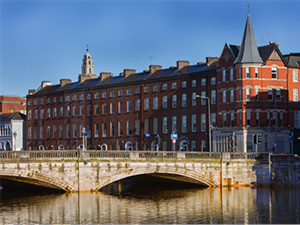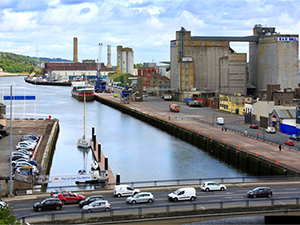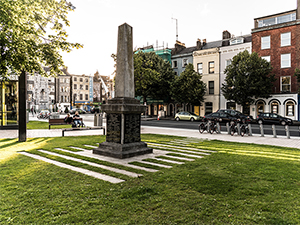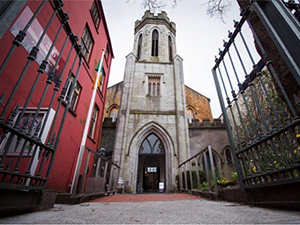Starting at 11:15 on Thursday 28 June, Day 2 of Congress
On the morning of Day 2 of Congress, you will have the opportunity to visit and learn about some of the inspirational elements in Cork. Read below for more information about each trip.

Just over St. Patrick’s Bridge, to the north city centre, you will visit the area with the highest concentration of Victorian Architecture in Cork City. This is a unique historical destination offering an eclectic mix of speciality retail, hospitality and entertainment experience within its splendid architectural setting. You will experience the “Steps and Steeples” with St. Patricks Hill and Bell’s Field offering spectacular views from which you can observe the historic urban heart of Cork with old and new additions to the city’s skyline, including St. Anne’s in Shandon.
The main street of this quarter is McCurtain Street, which contains many buildings of interests such as the Everyman Theatre (where Charlie Chaplin once performed), the Metropole Hotel and the former Thompsons Bakery. This historic street provides the setting for 24/7 vibrancy of shopping, leisure and entrainment.

This bike tour gives visitors to Cork a chance to experience the city’s iconic Docks and River Lee in the best way possible – whilst looking at what’s happened in the last 10 years in the main City Centre expansion area, and see where development will be happening over the next 30 years – Cork Docklands. The tour will give you an overview of the nationally significant development opportunities at Cork City Docks and Tivoli Docks and give you a feel for the challenges and complexities of delivery. As well as this you will see one of Cork’s internationally significant buildings – the former Ford Factory, the new Marina Park / Parc Ui Caoimh stadium development, Blackrock Harbour / village centre and Dundanion Court – Cork’s very own architect’s village. The tour will then head to the historic Jewish Quarter via the Old Railway green route and the northern edge of the City Docks.

The Heart of the City is Cork’s mixed-use commercial centre that creates a vibrancy vital to the well-being of the city and region. The area is the focus for retailing and social and cultural interaction, and is home to an expanding number of offices and is the centre of the city’s night time economy. The walk will give you a feel for the area and what makes it tick – as well as looking at recent retail, office, and educational developments, and examples of imaginative refurbishment and reuse of older buildings. Developed from the 1700s onwards the area has layers of history interspersed with the buzz and development of modern city life. You will also have a quick look into the internationally renowned English Market and walk along Oliver Plunkett St, winner of the Academy’s Great Street Award in 2016, before finishing at the Georgian Custom House/Bonded Warehouse.

This walking tour will concentrate on the topographical development of Cork City in the late eighteenth and early nineteenth centuries and will be led by local author and historian, Tom Spalding. It will explain: the development of the physical form of the city centre, especially the importance of culverting and of land reclamation, the role of place-naming within the context of social and political events and it will examine some key buildings on the route. The past of the city will be brought to life using visual aids and descriptions of quotidian details of the past.

This walking tour will involve travelling back in time to Cork’s medieval city and its streets and lanes, although the earliest built fabric that you will see will be from the 18th century. This area was the commercial high street of the city until the nineteenth century when Saint Patrick’s Street took that role. Having suffered from underinvestment for many decades today it has a reinvigorated energy as the heart of a city centre neighbourhood with an eclectic mix of businesses and people. The area’s transformation is galvanised around the transformation of the Brewery Quarter and an organic people-centred change on North Main Street, including volunteers from across Cork City that love the area and local developers. The tour will end in Shandon, a thriving City Centre neighbourhood on the hill to the north of the River Lee. Shandon is a very picturesque place with a fascinating history. It was once the site of world’s largest butter market and today provides the home to Cork’s favourite landmark – the St Anne’s Church tower with its salmon atop.

Connecting to the south side of the City Centre island, on the southern edge of the River Lee, the South Parish is a central element of Corks urban landscape. This neighbourhood is one of the oldest occupied parts of the City and home to some of its most magnificent churches. St Fin Barre’s Cathedral is believed to occupy the site of the 7th Century monastery founded by St Finbarr, the Patron Saint of Cork. Elizabeth Fort, Nano Nagle Place, Red Abbey and St. Nicholas Church are other important historic sites within walking distance of each other. Barrack Street, Douglas Street, The Quays and South Terrace together form the main streets set within a dense network of side streets and laneways that give the neighbourhood its unique character. Within this historic built environment an evolving and active local community and an adapting physical environment ensure the South Parish continues to grow while retaining its strong sense of neighbourhood and history.

Cork is a very old city but little above the ground dates from before the 1690s. The modern centre is largely a creation of the 18th century when Cork boomed on the expansion of trade with America. The tall narrow buildings of the merchants were built along new streets laid out over newly-created islands to the east of the medieval city, the islands separated by channels of the River Lee. Though most of the channels have long since been covered over to create the wide new streets such as St. Patrick’s St., Grand Parade or South Mall, the river still runs beneath, and it is reputed that some property owners even have mooring rights for boats on what is now solid ground.
The city has, for this reason, been called the ‘Venice-of-the-north’ but after this short walk through the 18th century city it will be clear why it might be more appropriately described as a Dutch city on the Atlantic.
